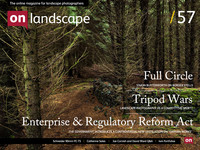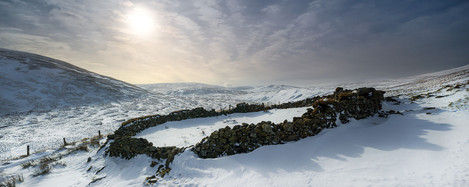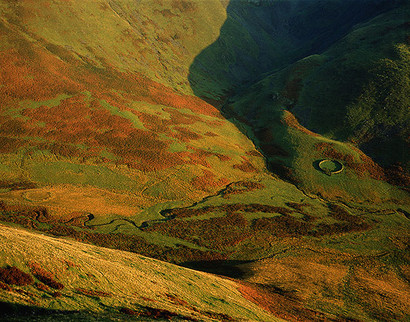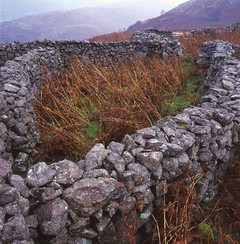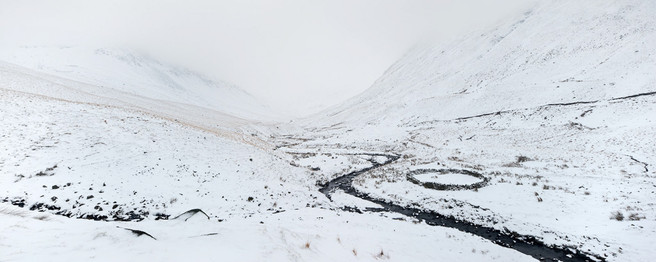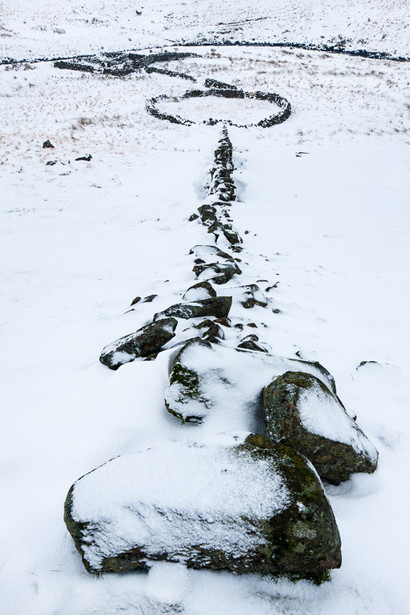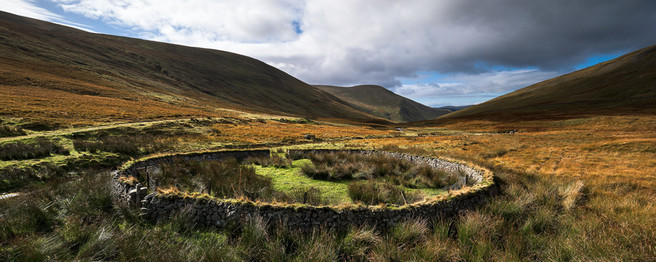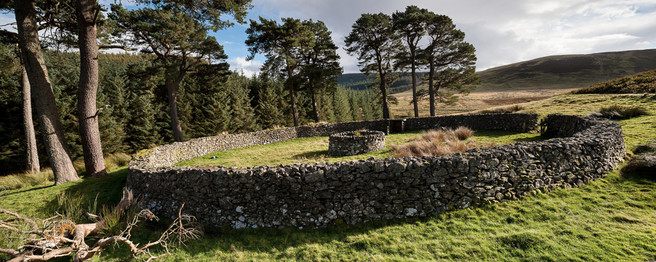Border Stells

Simon Butterworth
Simon Butterworth is a photographer and musician who lives in the Scottish Borders.
simonbutterworthphotography.com
Sheepfolds occur in all areas of upland Britain. They are known locally by different names and vary in construction from region to region. The type that has inspired me, known as stells, are common in the Border and Southern Upland areas of Scotland and are mostly circular, though I have come across square, and more unusually five- six- and even seven sided examples. The only other regions where I have seen circular folds are Perthshire, Sutherland and what appears to be a suspiciously stell-like structure on St Kilda.
Border stells were constructed from the early 1800s when a rising demand for fresh food was fuelled by the burgeoning urban population of the industrial revolution. In the economic climate of the times, sheep production was found to be the most profitable use of the remote hills and glens. A shortage of local timber meant stells had to be constructed from stone in the form of a 'drystane' dyke or wall. They were used to isolate sheep for various treatments without the inconvenience of having to transport them often long distances back to the valley farms. Once inside the stell, they would be safe from straying and could be easily caught for further examination. Nowadays, stells are used only at lambing time and are largely redundant, with many falling into disrepair.
I first became aware of stells when I saw Paul Wakefield's photograph of a fold near Tweedsmuir, featured in the February 1987 edition of Photography.
It amazed me that a perfect circle of stone could sit on a barren hillside and not attract huge amounts of attention; it looked as though it could be used in druidic earth-worshipping ceremonies, or it could even have been put there by aliens! For me, it had all the mysticism of a crop circle, but without the need for a small aeroplane to view it.
In 1996, Andy Goldsworthy initiated the project 'Sheepfolds' to celebrate the coming millennium. This was a development of his work using folds as placements for permanent sculptures. It was to be a celebration of the landscape of Cumbria and man's work within it.
When I see a stell hugging the contours of a hillside, it immediately brings Goldthsworthy's words to mind - "One of the greatest lessons of stone is that it has exactly those qualities that people say it doesn't have: that is, it is flowing, moving, changing, malleable - if you are prepared to understand it in those ways. The wall itself is an expression of movement: a line moving through the landscape". However, he goes on to say, "I'm always surprised when people talk of the circle recurring in my work: I'm even surprised by the word, because I never think of them as circles. The word has connotations of being imprinted whereas for me it's not a design, but a concentration of space. It's what's contained within that interests me, it's not the 'circle' as such. What I've always loved about sheepfolds is the way they concentrate the space within: the sheepfolds are not so much objects as spaces which are charged by the work and the sheepfold combined". This way of seeing folds is exactly the opposite of my own vision. I am fascinated by the sheepfold within the landscape: it is the interaction with the space around it which I find so compelling.
I live in the Borders - a beautiful place.....in fact, of the three geographical areas of Highland, Central and Southern Scotland, it is the least populated. The area contains bold rolling hills and broad fertile valleys. You can walk all day on the rounded, felty moors without seeing another soul; your only companions will be sheep which eke out a thin existence on the meagre upland vegetation. This is not photographers' country. Lack of features make the creation of good images difficult and completely reliant on outstanding light.
It was with no surprise that I read on Alex Nail's excellent website that, "Lanarkshire is not a county I can say I have experienced at all save for this one brief stop on the way back from the Isle of Skye. Its massive rolling hills seem quite unique although I think I would struggle to make exciting images without great light like this!". Since moving to this area nine years ago, it has been my ambition to reveal a little more of what a stunning landscape Border country is. As Alex has pointed out, most people pass through it on the way to the well-worn photographic hotspots further north.....only a few folks stop to explore in greater depth. It is against this background that my interest in stells as a thematic motif began to develop, eventually becoming a full-blown obsession.
As I explored the Border region in detail I began to notice stells on a regular basis. At first I thought there were only about half a dozen dotted across a huge geographical area; I thought they were fascinating but extremely rare. Now I know differently: there are hundreds, if not thousands of them. They are however, secretive and shy, and rarely reveal themselves without demanding that you work for the privilege. A master of camouflage, the stell blends perfectly with its environment, and learning to spot them is a slowly acquired skill. Google Earth has helped enormously, but can only tell you so much. What appears as a perfect circle from outer space may in reality be only a foot high - and definitely not worth a five mile walk.
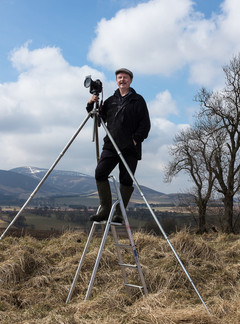 I decided to photograph only stells that are remarkable in some way: outstanding construction, unusual shape, or stunning situation. It would be easy to develop a trainspotter mentality and feel the need to photograph them all, but ultimately I am a interested in landscape photography and not definitive historical record keeping. I have also become aware of the stell as emblematic of changing land use; this is why the images feature motorways, forestry, power generation and water. One picture shows how a commercial forest was planted around a stell, had grown to full size, been clearcut, and now the sheep are slowly coming back to re-colonise... Full Circle.
I decided to photograph only stells that are remarkable in some way: outstanding construction, unusual shape, or stunning situation. It would be easy to develop a trainspotter mentality and feel the need to photograph them all, but ultimately I am a interested in landscape photography and not definitive historical record keeping. I have also become aware of the stell as emblematic of changing land use; this is why the images feature motorways, forestry, power generation and water. One picture shows how a commercial forest was planted around a stell, had grown to full size, been clearcut, and now the sheep are slowly coming back to re-colonise... Full Circle.
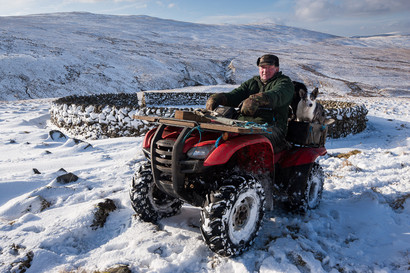 The demands of the project have stretched me both physically and mentally. I experimented extensively with format before settling on panoramic (the Southern Upland landscape is essentially widescreen). I'm using 3 x 2 for the detailed shots and stitched 2.5 x 1 panoramas for what I think of as the 'official portraits'. Stells are up to six feet in height; this creates the problem of showing that it is circular and not just an isolated wall. I have overcome this by using an old Gitzo tripod which extends up to about ten feet, so I then need a ladder to reach the camera. This appears to be a good solution, but the whole lot has then to be carried - often for several miles across wild and hilly country, sometimes in bad weather. Just before Christmas I fell off the ladder (as you can imagine, it often has to be placed on a soft or unstable surface), landing badly and hurting my back in the process. I then had a two or three mile struggle back to the car carrying a heavy, scaffolding-like tripod, a step ladder and a camera bag. Needless to say, I wasn't up to venturing far for the next couple of weeks.
The demands of the project have stretched me both physically and mentally. I experimented extensively with format before settling on panoramic (the Southern Upland landscape is essentially widescreen). I'm using 3 x 2 for the detailed shots and stitched 2.5 x 1 panoramas for what I think of as the 'official portraits'. Stells are up to six feet in height; this creates the problem of showing that it is circular and not just an isolated wall. I have overcome this by using an old Gitzo tripod which extends up to about ten feet, so I then need a ladder to reach the camera. This appears to be a good solution, but the whole lot has then to be carried - often for several miles across wild and hilly country, sometimes in bad weather. Just before Christmas I fell off the ladder (as you can imagine, it often has to be placed on a soft or unstable surface), landing badly and hurting my back in the process. I then had a two or three mile struggle back to the car carrying a heavy, scaffolding-like tripod, a step ladder and a camera bag. Needless to say, I wasn't up to venturing far for the next couple of weeks.
Like many projects, this one has developed its own momentum. As a subject for study, Border stells at first seemed limited and narrow, but I am now endeavouring to contain what the American military would no doubt describe as 'project creep'. With many more images in mind, I will be expanding this series for some months to come.
- Linfoots
- M74
- Talla
- Tweeddale
- Big Knock
- Drift
- Flexible
- Forestry
- Stell and stell
- Gameshope
- Glentress
- Moffatdale
- Garelet Hill
- Great Hill
- Black Hope Blizzard
- Black Hope

